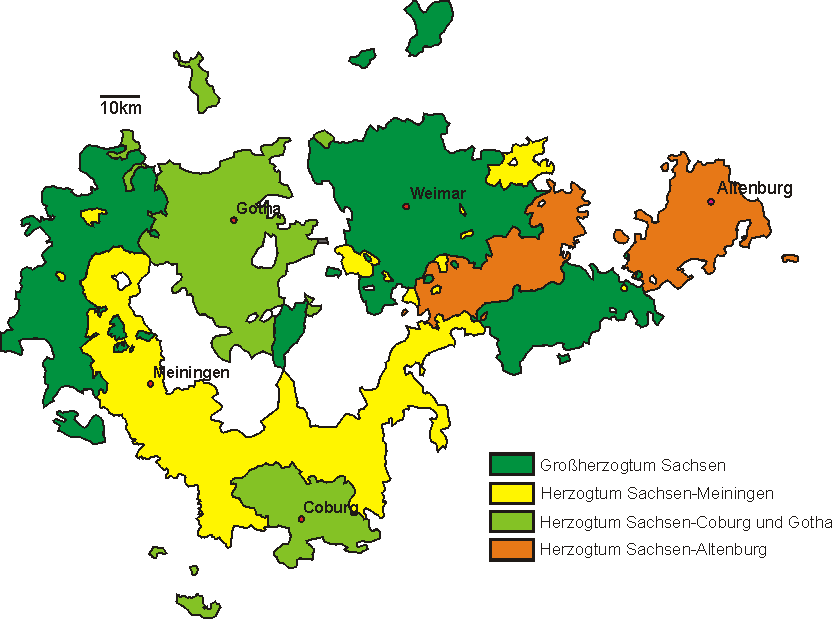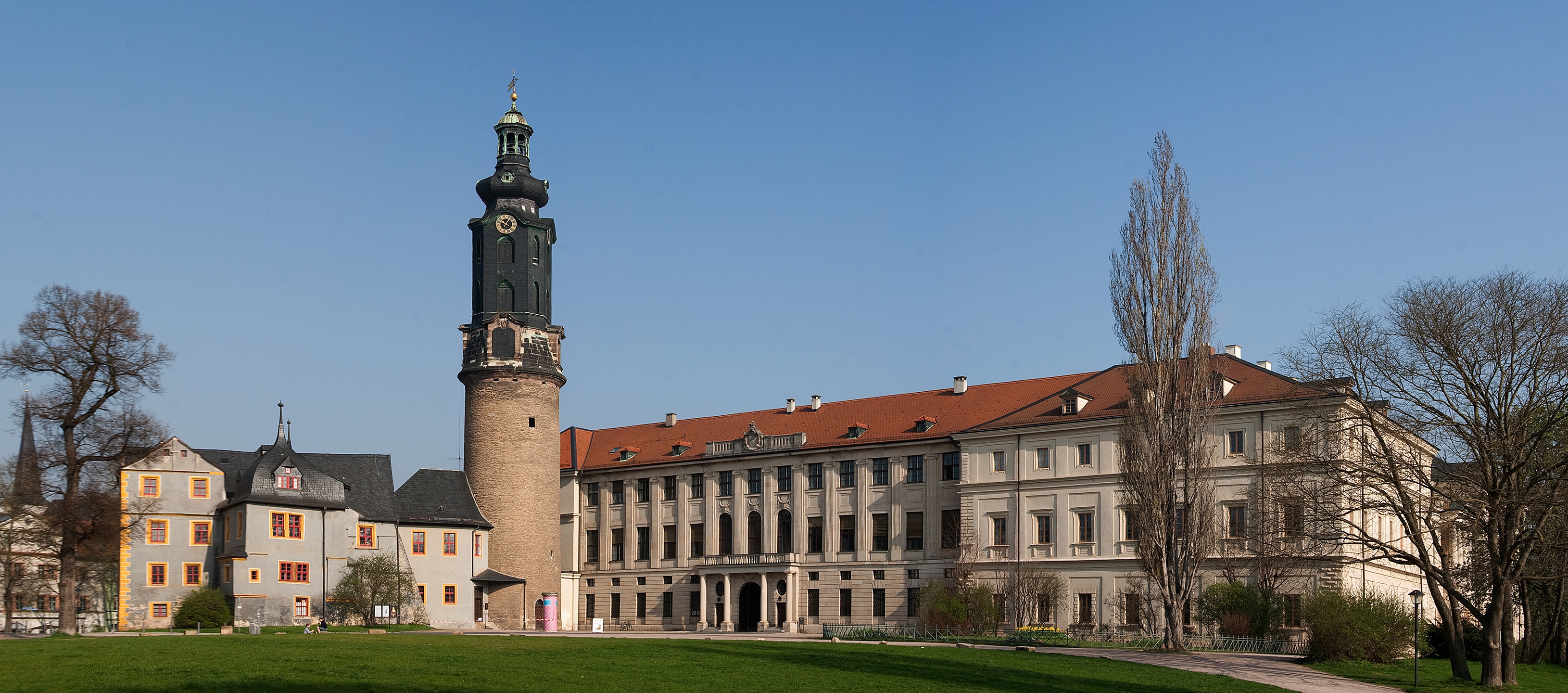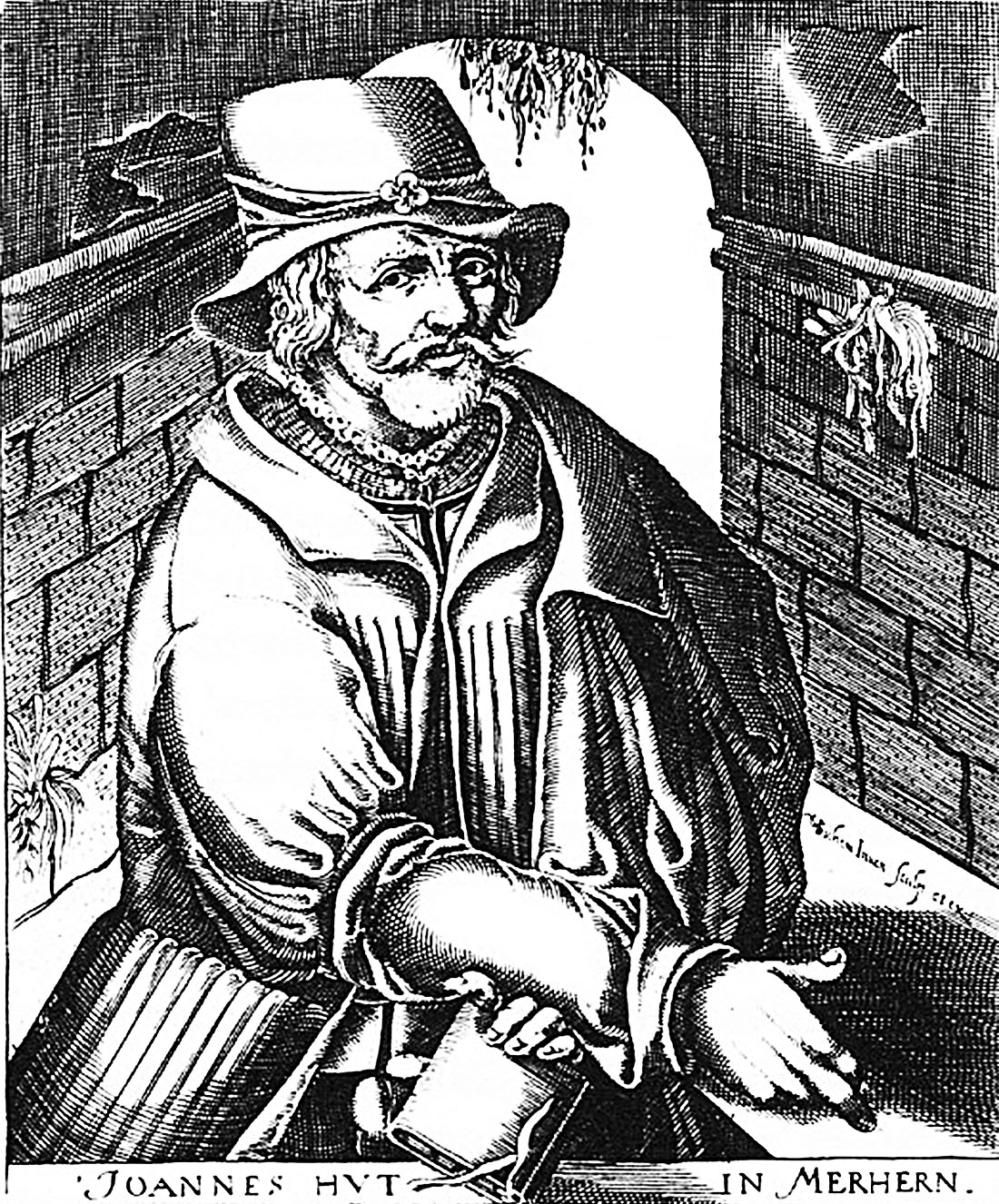|
John Philip, Duke Of Saxe-Altenburg
Johann Philipp (25 January 1597 – 1 April 1639), was a duke of Saxe-Altenburg. He was born in Torgau, the eldest (but fourth in order of birth) surviving son of Friedrich Wilhelm I, Duke of Saxe-Weimar and Anna Maria of the Palatinate-Neuburg, his second wife. Childhood When his father died (1602), Johann Philipp and his younger brothers Frederick, Johann Wilhelm and Friedrich Wilhelm were underage. Because of this, his uncle Johann (more interested in natural sciences and art than politics) took over his guardianship and the regency of his inheritance; but shortly after he took all the duchy of Saxe-Weimar into his own hands. The next year (1603), the young prince of Saxe-Weimar demanded his own inheritance, but his uncle Johann opposed this. But finally, both parts made a divisionary treaty of the family lands: Johann Philipp and his brothers took Altenburg and some towns, and Johann retained Weimar and Jena. Because they were still underage, the regency of his duchy w ... [...More Info...] [...Related Items...] OR: [Wikipedia] [Google] [Baidu] |
Duke Of Saxe-Altenburg
Saxe-Altenburg (german: Sachsen-Altenburg, links=no) was one of the Saxon duchies held by the Ernestine branch of the House of Wettin in present-day Thuringia. It was one of the smallest of the German states with an area of 1323 square kilometers and a population of 207,000 (1905) of whom about one fifth resided in the capital, Altenburg. The territory of the duchy consisted of two non-contiguous territories separated by land belonging to the Principality of Reuss. Its economy was based on agriculture, forestry, and small industry. The state had a constitutional monarchical form of government with a parliament composed of thirty members chosen by male taxpayers over 25 years of age. History The duchy had its origins in the medieval Burgraviate of Altenburg in the Imperial Pleissnerland ''(Terra Plisensis)'', a possession of the Wettin Margraves of Meissen since 1243. Upon a partition treaty of 1485, Altenburg fell to Ernst, Elector of Saxony, the progenitor of the Ernestine We ... [...More Info...] [...Related Items...] OR: [Wikipedia] [Google] [Baidu] |
University Of Leipzig
Leipzig University (german: Universität Leipzig), in Leipzig in Saxony, Germany, is one of the world's oldest universities and the second-oldest university (by consecutive years of existence) in Germany. The university was founded on 2 December 1409 by Frederick I, Elector of Saxony and his brother William II, Margrave of Meissen, and originally comprised the four scholastic faculties. Since its inception, the university has engaged in teaching and research for over 600 years without interruption. Famous alumni include Gottfried Wilhelm von Leibniz, Johann Wolfgang von Goethe, Leopold von Ranke, Friedrich Nietzsche, Robert Schumann, Richard Wagner, Tycho Brahe, Georgius Agricola, Angela Merkel and ten Nobel laureates associated with the university. History Founding and development until 1900 The university was modelled on the University of Prague, from which the German-speaking faculty members withdrew to Leipzig after the Jan Hus crisis and the Decree of Kutná H ... [...More Info...] [...Related Items...] OR: [Wikipedia] [Google] [Baidu] |
Philipp Ludwig, Count Palatine Of Neuburg
Philipp Ludwig of Neuburg (2 October 1547 – 22 August 1614) was the Duke of Palatinate-Neuburg from 1569 until 1614. Life Philipp Ludwig was born in Zweibrücken in 1547 as the eldest son of Wolfgang, Count Palatine of Zweibrücken. After his father's death in 1569, his lands were partitioned between Philipp Ludwig and his four brothers - Philipp Ludwig received the Duchy of Neuburg. He married Anna (1552–1632), daughter of Duke Wilhelm IV "the Rich" of Jülich-Cleves-Berg, in 1574 and used the marriage as the basis of his claim to inherit the duchies in the succession controversy against the Elector of Brandenburg after William IV's only son, John William, died without heirs. In 1613 Philip Louis's eldest son converted to Catholicism and gained the support of Spain and the Catholic League while Brandenburg received the support of the Netherlands. The conversion of his son and heir was very difficult for the staunchly Lutheran Philipp Ludwig. By the Treaty of Xanten in 16 ... [...More Info...] [...Related Items...] OR: [Wikipedia] [Google] [Baidu] |
Dorothea Susanne Of Simmern
Dorothea Susanne of Simmern (15 November 1544 in Simmern – 8 April 1592 in Weimar) was a princess of the Electorate of the Palatinate and by marriage Duchess of Saxe-Weimar. Life Dorothea Susanne was the daughter of elector palatine Frederick III (1515–1576) from his marriage to Princess Marie of Brandenburg-Kulmbach (1519–1567), daughter of Margrave Casimir of Brandenburg-Kulmbach. She married on 15 June 1560 in Heidelberg Duke John William, of Saxe-Weimar (1530–1573). After their marriage, the couple lived mostly in Weimar. After the death of her husband Elector August of Saxony acted as guardian of her children. This policy was meant to isolate the children from their mother's political and religious influence. She was assigned a new residence outside Weimar, appropriately named ''New House''. The Red Castle in Weimar was built for her from 1574 to 1576. She used it as her widow seat after its completion. Its Renaissance portal is decorated with an alli ... [...More Info...] [...Related Items...] OR: [Wikipedia] [Google] [Baidu] |
Johann Wilhelm, Duke Of Saxe-Weimar
Johann Wilhelm (11 March 1530 – 2 March 1573) was a duke of Saxe-Weimar. Life He was the second son of Johann Frederick I, Elector of Saxony, and Sibylle of Cleves. At the time of his birth, his father still carried the title Elector of Saxony, but he lost it in 1547 after his defeat and capture by the Emperor Charles V due to his support of the Protestant Reformation. Johann Frederick was released and forced to adopt the lesser title of duke of Saxony in an area substantially smaller than his former lands in Thuringia. In 1554, after the death of his father, Johann Wilhelm inherited the duchy of Saxony with his older brother, Johann Friedrich II, and his younger brother, Johann Friedrich III. The three brothers divided the duchy: Johann Friedrich II as head of the family took Eisenach and Coburg; Johann Wilhelm received Weimar; and Johann Friedrich III inherited Gotha. In 1565, however, when Johann Frederick III died without heirs, the two surviving brothers drew up a new t ... [...More Info...] [...Related Items...] OR: [Wikipedia] [Google] [Baidu] |
Ernest I, Duke Of Saxe-Gotha
Ernest I, called "Ernest the Pious" (25 December 1601 – 26 March 1675), was a duke of Saxe-Gotha and Saxe-Altenburg. The duchies were later merged into Saxe-Gotha-Altenburg. He was the ninth but sixth surviving son of Johann II, Duke of Saxe-Weimar, and Dorothea Maria of Anhalt. His mother was a granddaughter of Christoph, Duke of Württemberg, and great-granddaughter of Ulrich, Duke of Württemberg. Life Left an orphan early in life (his father died in 1605 and his mother in 1617), he was brought up in a strict manner, and was gifted and precocious but not physically strong. He soon showed traits of the piety of the time. As ruler, by his character and governmental ability as well as by personal attention to matters of state, he introduced a golden age for his subjects after the ravages of the Thirty Years' War. By wise economy, which did not exclude fitting generosity or display on proper occasions, he freed his land from debt, left at his death a considerable sum in the tr ... [...More Info...] [...Related Items...] OR: [Wikipedia] [Google] [Baidu] |
Saxe-Gotha
Saxe-Gotha (german: Sachsen-Gotha) was one of the Saxon duchies held by the Ernestine branch of the Wettin dynasty in the former Landgraviate of Thuringia. The ducal residence was erected at Gotha. History The duchy was established in 1640, when Duke Wilhelm von Saxe-Weimar created a subdivision for his younger brother Ernest I the Pious. Duke Ernest took his residence at Gotha, where he had ''Schloss Friedenstein'' built between 1643 and 1654. At the same time, the Duchy of Saxe-Eisenach was created for the third brother Albert IV. Nevertheless, Albert died in 1644, and Ernest inherited large parts of his duchy, though not the core territory around the residence at Eisenach and the Wartburg, which fell to his elder brother Wilhelm of Saxe-Weimar. Ernest could also incorporate several remaining estates of the extinct House of Henneberg in 1660, which had been vacant since 1583. Finally in 1672 he received the major part of Saxe-Altenburg through his wife Elisabeth Sophie, af ... [...More Info...] [...Related Items...] OR: [Wikipedia] [Google] [Baidu] |
John Ernest, Duke Of Saxe-Eisenach
Johann Ernst of Saxe-Eisenach (Gotha, 9 July 1566 – Eisenach, 23 October 1638), was a duke of Saxe-Eisenach and later of Saxe-Coburg. He was the fourth (but second surviving) and youngest son of Johann Frederick II, Duke of Saxony and Countess Palatine Elisabeth of Simmern-Sponheim. His grandfather, Johann Frederick I, had still held the title of Elector of Saxony, but after the Battle of Mühlberg he lost the title to his cousin Maurice, from the Albertine line. His father tried since then to regain the Electorate again for the Ernestine line. For this purpose he accepted an outlawed knight, Wilhelm von Grumbach, with himself, which led finally to the fact that also over his father the anger of the Emperor. Only one year after his birth was besieged the castle of his father in Gotha by troops of the Elector Augustus of Saxony and finally conquered. His father came into imperial prison from the rest of his life. His mother, Johann Ernst and his older brothers had to flee ... [...More Info...] [...Related Items...] OR: [Wikipedia] [Google] [Baidu] |
Saxe-Weimar
Saxe-Weimar (german: Sachsen-Weimar) was one of the Saxon duchies held by the Ernestine branch of the Wettin dynasty in present-day Thuringia. The chief town and capital was Weimar. The Weimar branch was the most genealogically senior extant branch of the House of Wettin. History Division of Leipzig In the late 15th century much of what is now Thuringia, including the area around Weimar, was held by the Wettin Electors of Saxony. According to the 1485 Treaty of Leipzig, the Wettin lands had been divided between Elector Ernest of Saxony and his younger brother Albert III, with the western lands in Thuringia together with the electoral dignity going to the Ernestine branch of the family. Ernest's grandson Elector John Frederick I of Saxony forfeited the electoral dignity in the 1547 Capitulation of Wittenberg, after he had joined the revolt of the Lutheran Schmalkaldic League against the Habsburg emperor Charles V, was defeated, captured and banned. Nevertheless, according ... [...More Info...] [...Related Items...] OR: [Wikipedia] [Google] [Baidu] |
Neustadt Bei Coburg
Neustadt bei Coburg (also written ''Neustadt b. Coburg'') is a town in the district of Coburg in northern Bavaria, Germany. It is situated 15 km northeast of Coburg, as its name indicates. Local subdivisions Neustadt bei Coburg is subdivided into 22 local unites (Ortsteile): History The Middle Ages In the second half of the 12th century, Count Hermann von Wolweswac founded the town of Neustadt with the building of a castle. Governance of the city was left to the Counts of Andechs, the later Dukes of Meranien. Neustadt is first mentioned in a document from the 16th of June, 1248, describing the "market forum" ("Marktflecken") of Neustadt. In 1316, Neustadt was designated a City, and in 1353, Neustadt came under the care of Coburg, making it a possession of the House of Wettin, which is remained until the First World War. Under Wettin rule, the city acquired the two-tailed, red and black lions which grace its coat of arms. Neustadt lay on a major trade route between Nürn ... [...More Info...] [...Related Items...] OR: [Wikipedia] [Google] [Baidu] |
Hildburghausen
Hildburghausen (IPA adapted from: ) is a town in Thuringia in central Germany, capital of the district Hildburghausen. Geography It is situated in the Franconian part of Thuringia south of the Thuringian Forest, in the valley of the Werra river. The town centre is located about south of Suhl and northwest of Coburg. History The settlement of ''Hilteburgehusin'' was first mentioned in a 1234 deed, when the Counts of Henneberg sold it to the Prince-Bishops of Würzburg. Repurchased in 1316, the Henneberg lords vested the citizens with town privileges in 1324 and had city walls erected. In 1353 the estates of Hildburghausen were inherited by the Wettin landgrave Frederick III of Thuringia and upon the 1485 Treaty of Leipzig became part of the Ernestine duchies. In 1528 the Hildburghausen citizens turned Protestant. The town fell to the newly established Duchy of Saxe-Coburg in 1572 and upon the extinction of the line in 1638 passed to the Duchy of Saxe-Altenburg. In 1680 it ... [...More Info...] [...Related Items...] OR: [Wikipedia] [Google] [Baidu] |
Römhild
Römhild () is a town in the district of Hildburghausen, in Thuringia, Germany. It is situated 14 km west of Hildburghausen, and 21 km southeast of Meiningen. On 31 December 2012, it merged with the former municipalities Gleichamberg, Haina, Mendhausen, Milz and Westenfeld. In the Stadtkirche of Römhild is the tomb of Elisabeth (a daughter of Albrecht III Achilles, Elector of Brandenburg) and Hermann VIII of Henneberg. The grave has sometimes been attributed to Herman Vischer the Younger (c.1486–1517), a member of the Vischer Family of Nuremberg. Sons and daughters of the town * Hans Hut (1490–1527), Anabaptist * Lucas Maius (1522–1598), Protestant theologian and dramatist * Max Saalmüller (1832–1890), Prussian Lieutenant-Colonel and Lepidopterologist * Alfred Götze (1865–1948), Prehistorian Prehistory, also known as pre-literary history, is the period of human history between the use of the first stone tools by hominins 3.3 million years ... [...More Info...] [...Related Items...] OR: [Wikipedia] [Google] [Baidu] |




